To mark the 35th anniversary of the launch of the legendary Canon EOS System, we’ve delved into our memories to put together what we believe are the Top 12 Best EOS Cameras Ever, both film SLRs and DSLRs.
Read on to find out what we chose and why, along with what makes these cameras special…
When did Canon launched its EOS System?
On 2 March 1987 Canon launched its EOS System with the debut of the EOS 650 single-lens reflex (SLR) camera and the new EF lens mount (with a trio of EF lenses).
At the time it was regarded by many as a risky move as it saw the abandonment of the FD lens mount, which had been the optical pillar of Canon’s SLR system since 1958, spanning 29 years.
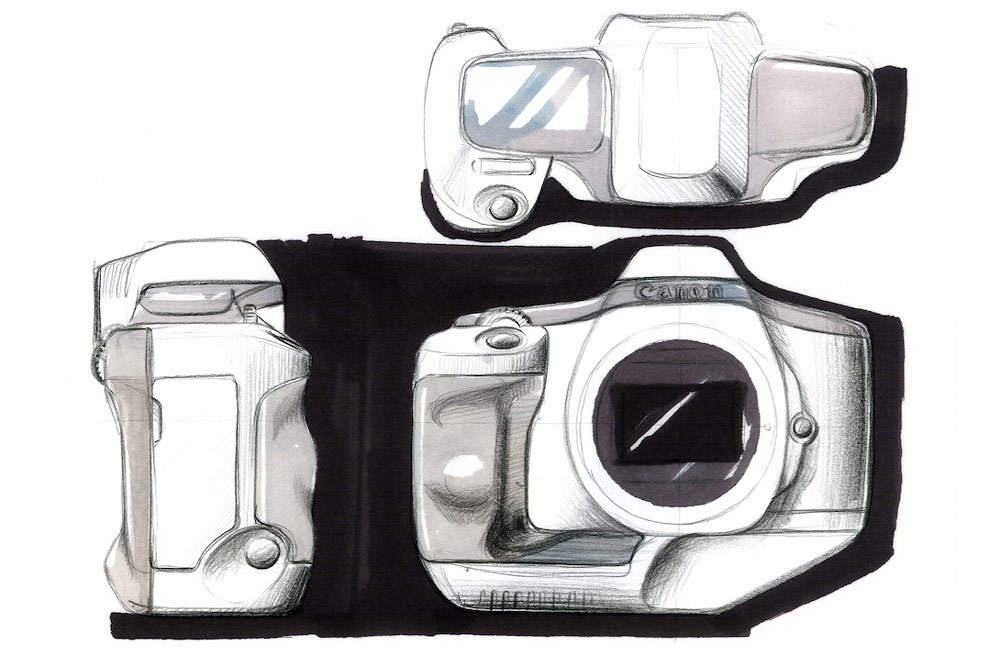
Canon’s drawings for the EOS 1 series DSLRs, Image courtesy: Canon
The new EOS era
The EOS era – which stands for Electro-Optical System, as well as being the name of the Greek Goddess of the dawn – had begun, with a new EF-mount.
At launch, the EOS system had three core principles – speed, image quality and ease of use. That trio of key factors still holds true today.
Since the March 1987 launch of the EOS System there have been 35mm film cameras, digital cameras, mirrorless cameras, Cinema EOS cameras, Advanced Photo System (APS) cameras, 50MP cameras, 8K video cameras and over 150 million lenses – discover the best RF-mount lenses to buy for a look at the cutting edge of lens tech – sold for all of the EOS systems. And if you’re struggling to pick which type of camera is right for you, check out our guide to DSLR vs mirrorless: which is best.
So, without further ado, here are our choices of The 12 Best Canon EOS Cameras Ever…
Best Canon EOS SLR film cameras:
1. Canon EOS 650 (1987)

The Canon EOS 650 was the first ever camera in Canon’s EOS range
Canon’s first-ever EOS camera took much of its design inspiration from the legendary manual focus Canon T90 SLR (launched in 1986), which was nicknamed ‘The Tank’ by Japanese photojournalists.
Despite looking dated today, it still has many of the attributes of later EOS camera bodies… such as a sculpted handgrip, a multi-purpose electronic control dial and a curvaceous body design.
Held up to modern day cameras, the specifications of the EOS 650 appear somewhat basic but it did offer a single autofocus point and a 6-zone metering system.
The controls were also slightly strangely arranged and it would take another few years for Canon to fully develop the standard EOS control layout that we recognise today.
The 650 has stood the test of time and the body works perfectly well with modern day EF-mount lenses.
Fascinating fact: an EOS 650 SLR was used to take the first-ever photographic image uploaded to the World Wide Web – a picture of the band Les Horribles Cernettes. It was personally requested by Sir Tim Berners-Lee (the inventor of the World Wide Web).
2. Canon EOS 100 (1991)
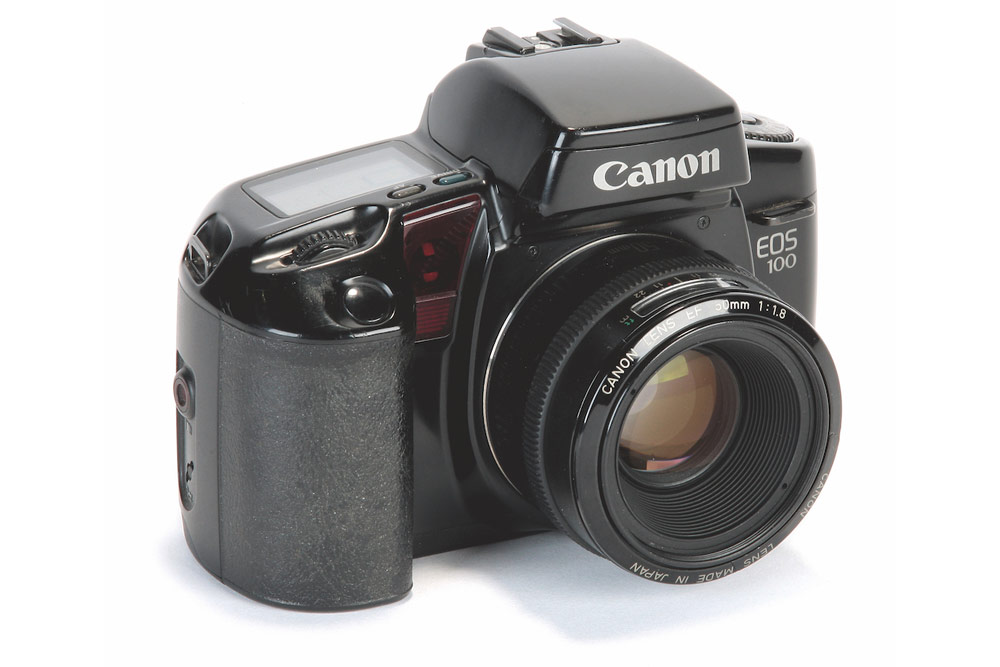
The 1991-launched EOS 100 established the design template for modern SLRs
Designed for enthusiast photographers, today the EOS 100 appears conventional and unremarkable, with twin electronic dials to handle exposure settings, a top-plate mode dial and a built-in flash. But, in fact, it was the first EOS camera to bring all of these elements together, thereby establishing the design template for most modern SLRs.
It also introduced a concept of ‘silent’ operation, which was welcome in an age when autofocus motors buzzed away noisily, and shutter and film-winding noises precluded any discreet photography.
Interestingly, it also shot at three frames per second and drive could be disabled to allow up to nine multiple exposures.
The EOS 100 cemented Canon’s reputation as a maker of well-designed SLRs that provided the features that enthusiasts wanted, without getting sidetracked by gimmicky add-ons.
Fascinating fact: the EOS 100 used a Barcode Program input system (scanned via the EOS Barcode Reader E). You could choose a shooting situation from a EOS Photo Files barcode picture book (with 23 barcodes) or the EOS Barcode 101 book (with 101 modes). You could then store up to five programs in Command dial positions.
3. Canon EOS-1N RS (1995)
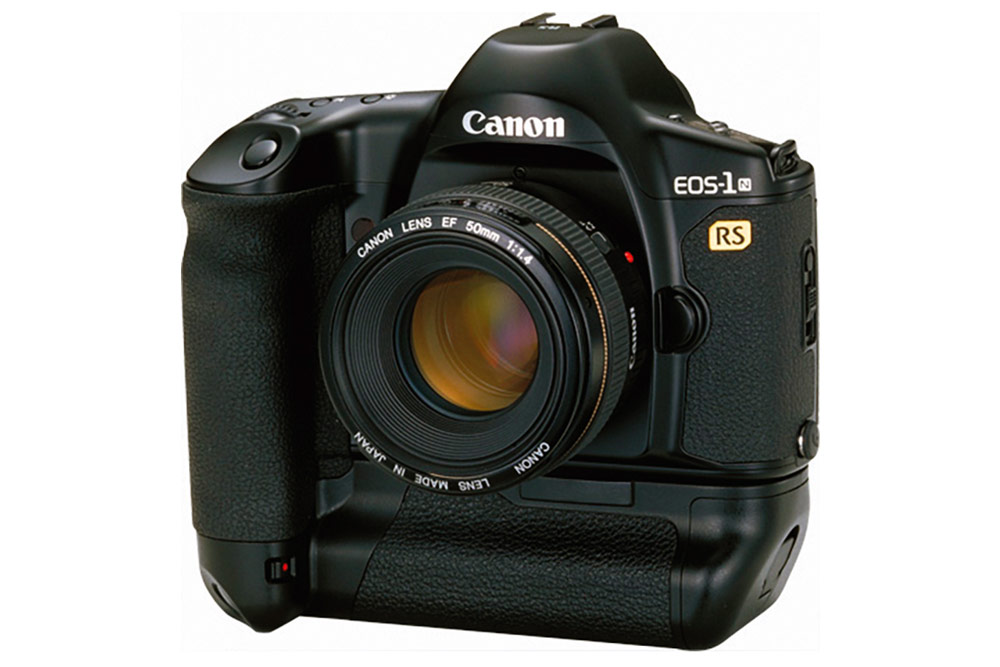
The Canon EOS-1N RS shot at 10 frames per second
By the mid-1990s Canon had established itself as the leading camera brand for shooting action pictures, thanks to its fast-focusing, ultrasonic motor (USM) telephoto lenses.
Its top of the range EOS-1 series pro bodies had also gained a reputation for toughness, reliability and speed.
In terms of speed, the EOS-1N RS was peerless, capable of shooting at a blistering 10 frames per second. Canon achieved this speed through using a fixed, semi-silvered ‘pellicle’ mirror that didn’t need to flip up and down for the camera to make an exposure.
The payoff for this speed, though, was that less light was reaching the film (as some was being directed up to the viewfinder), so photographers had to use faster lenses, slower shutter speeds or higher ISO speed films to try to ensure they maintained image quality in their 35mm film pictures.
Fascinating fact: the ‘RS’ in the EOS-1N RS name stands for (R)eal-time (S)uper-high-speed continuous shooting operation, due to its rapid time-lag speed of just 0.006sec.
4. Canon EOS 50E (1995)

The Canon EOS 50E was the first camera to use Canon’s E-TTL flash metering system
There was a mini revival of retro-styled, 35mm SLRs in the mid-1990s with designs moving away from the black polycarbonate skins, that had become the norm, to body ‘skins’ that featured silver-coloured tops and base plates.
With the EOS 50E, Canon went a step further and included top-plate analogue dials for autofocus, drive and metering modes in place of its usual buttons.
Most of the body was plastic, apart from the lens mount and the top plate, which was protected with an aluminium cover.
Technologically, the EOS 50E was also innovative, being the first model to use Canon’s pre-flash-based E-TTL flash metering system, alongside eye-controlled focus (even when shooting vertically) and Canon’s unique depth-of-field mode. Together, this all added up to one of the most likeable 35mm AF DSLRs of its time.
Fascinating fact: the eye-controlled autofocus system in the EOS 50E used three different focus points marked prominently in the viewfinder, so you could change focus point quickly with your eye.
5. Canon EOS-3 (1998)
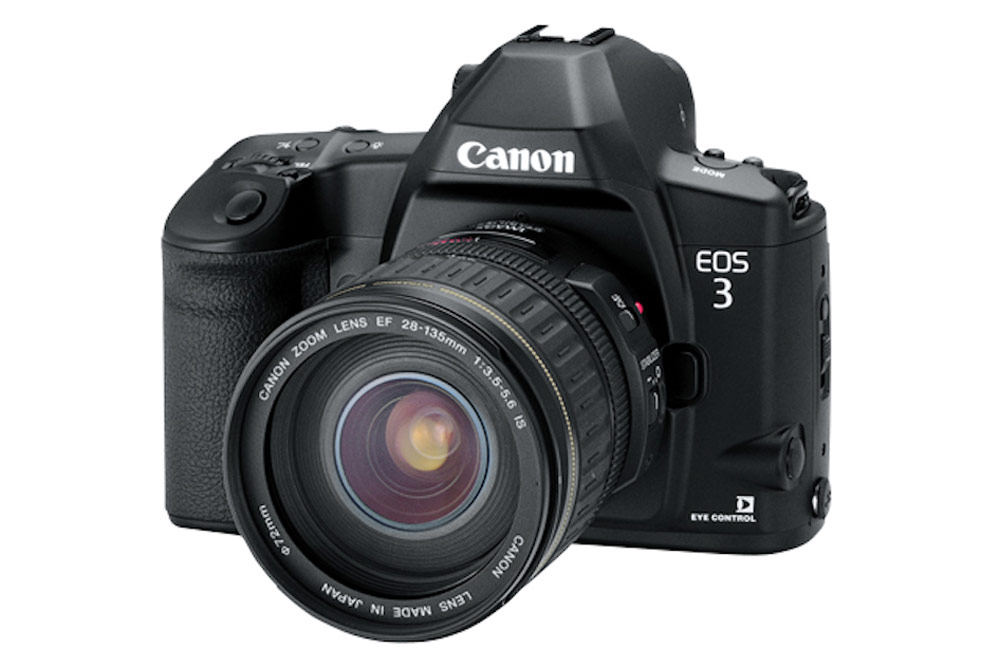
The Canon EOS-3 included a 45-point, eye-controlled AF system
To be honest, few 1990s SLRs are ever likely to be considered design classics, but if there’s one model that might set the hearts of Canon users to race… it’s the phenomenal EOS-3.
When it was released, this beast of a camera actually ‘out-specced’ the professional EOS-1N SLR, with a near-identical body design but skinned with lightweight plastic rather than metal.
It included an extraordinary 45-point eye-controlled autofocus system (which, sadly, could be fooled by spectacle wearers or contact lenses), shooting at up to seven frames per second and an advanced multi-spot metering system.
Its status among Canon users became so exalted that, for years after its launch, many were hoping for a ‘digital EOS-3’, before the EOS 5D Mark III finally, effectively, filled that role when it launched in 2012.
Fascinating fact: the EOS-3 remained on sale for approximately nine years, until 2007, and was the last camera outside of the EOS-1 series to boast Canon’s top-of-the-line AF system till the 5D Mark III.
6. Canon EOS-1V (2000)
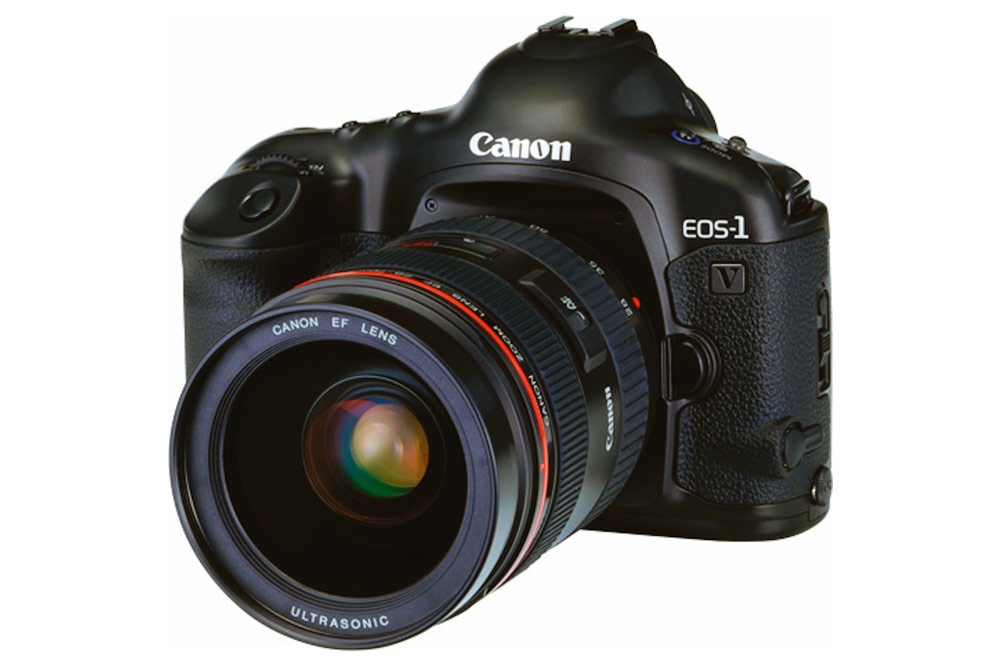
The Canon EOS-1 V was a film camera that stored shooting data
At the time of its launch the EOS-1V 35mm film SLR was the fastest moving-mirror film camera in production, with up to 10 frames per second shooting (with a PB-E2 power drive booster attached).
The camera’s body design formed the basis for subsequent EOS-1 series DSLRs, such as the EOS-1D and the EOS-1Ds ranges.
The ‘V’ in the name was used for two reasons – it signified the fifth generation of Canon professional SLRs and the company also claimed the ‘V’ stood for ‘vision’.
The spec included a 45-point area AF with predictive AI servo AF at 9fps, 20 custom functions and 31 ‘personal functions’.
As its name suggests, these personal functions allowed photographers to set up the camera to their favourite settings, but this had to be done but utilising the ES-E1 software and hooking the camera up to a computer.
Fascinating fact: the EOS-1V stored shooting data for 100 rolls of 36 exposure film (standard settings) in its memory – this could then be read and edited on a computer using EOS Link ES-E1 software.
Best Canon EOS DSLR cameras:
1. Canon EOS D30 (2000)
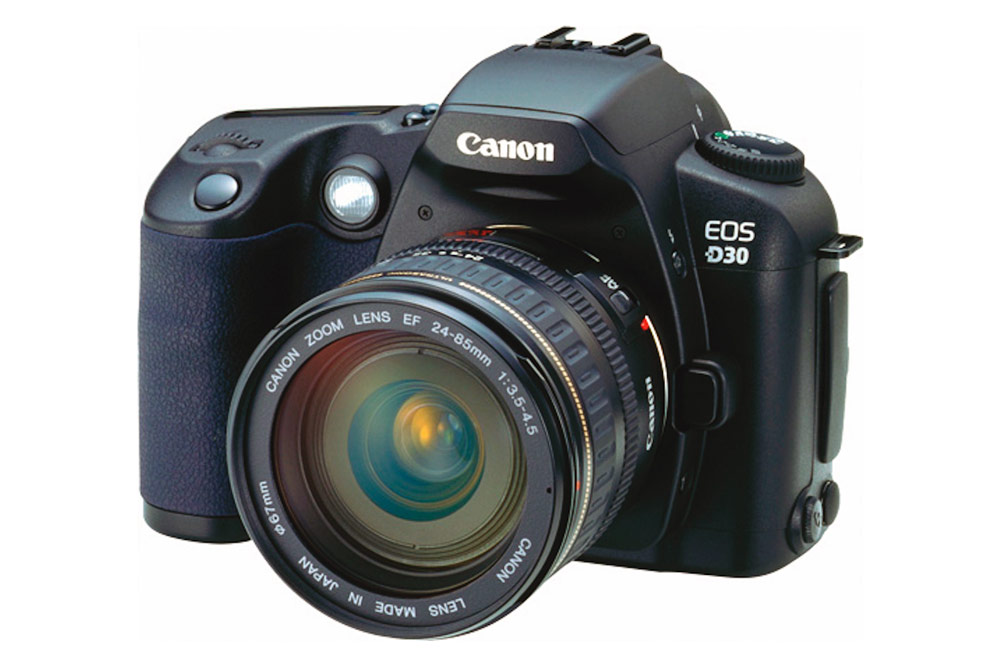
The Canon EOS D30 was the first-ever ‘all Canon’ digital SLR model
With its first ‘home-grown’ DSLR the Canon EOS D30 (following an alliance with Kodak that combined Kodak digital backs with Canon SLR camera bodies), Canon gave us a glimpse of the future.
What was the first Canon DSLR? The Canon EOS D30, released in 2000, was the first Digital SLR made entirely by Canon.
No bigger than a conventional 35mm SLR, it was the first commercial camera to be equipped with a large APS-C CMOS sensor, with a 3-million-pixel-resolution and sensitivity settings all the way up to ISO 1600.
At around £1,850 body only, it was affordable to many pro photographers and didn’t look entirely unreachable to amateurs either – the very definition of a ‘prosumer’ camera.
Its three-point autofocus was rather basic and its rear screen was tiny (it was 1.8 inches, 46mm) and had low resolution.
But, despite its flaws, the Canon EOS D30 was certainly one of the key milestones in the transition from film cameras to digital cameras.
Fascinating fact: the D30 was originally supplied with a 16MB CompactFlash card that could only hold 10 large/fine JPEGs, although much larger capacity CF and CF Type II cards could be used with the camera.
2. Canon EOS 300D (2003)

The Canon EOS 300D was notable as the first ever sub-£1,000 DSLR
Arguably the turning point in the digital revolution, the EOS 300D was the first ever sub-£1,000 DSLR.
By placing a six-million-pixel sensor in a stripped-down plastic body, Canon put an interchangeable lens digital camera into the hands of consumers for the first time.
It also debuted a modified lens mount, that took a new range of EF-S optics designed specifically for the APS-C sensor.
The 300D was launched with an EF-S 18-55mm zoom as its kit lens – this optic was available in a USM version in Japan but was a non-USM lens everywhere else in the world.
However, with severe restrictions on the selection of settings, such as autofocus and metering mode, Canon came in for some criticism for ‘crippling’ the 300D. The company subsequently reinstated these features in its successor, the 8-million-pixel Canon EOS 350D (which arrived in 2005).
The Canon EOS 300D line-up continued with the 350D, 400D, 450D, and so-on, with new models released every year, until the most recent model, the 24MP Canon EOS 850D in 2020/2021.
Fascinating fact: the 300D polycarbonate bodies were initially only available in North America in silver, with the Japanese version also in black. Black versions came later to the US and Europe.
3. Canon EOS 5D (2005)
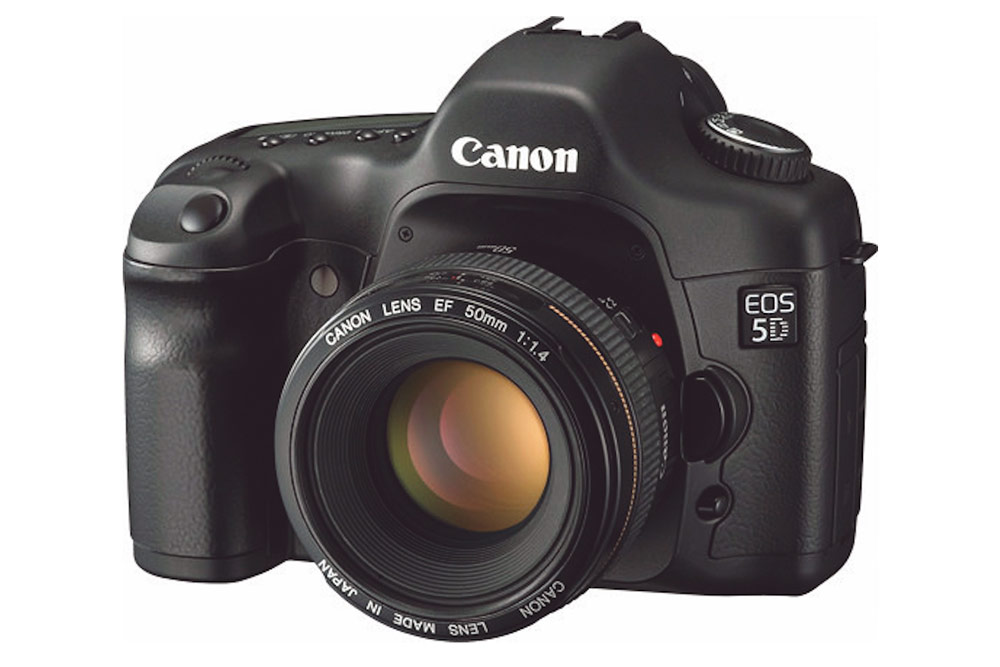
The Canon EOS 5D was an affordable, 13MP, full-frame DSLR
The EOS 5D was another iconic model in the development of digital, as it was the first affordable full-frame DSLR.
With a 12.8MP (13-million-pixel) sensor, it cost around £1,800 – less than the D30 that was launched five years earlier.
With few crop-sensor lenses yet to appear on the market this was a big deal, as professionals and serious amateurs could use their existing EF lenses as they were designed. They also benefitted from the camera’s excellent resolution and high ISO performance (with an ‘H’ setting of ISO 3200).
The 5D also incorporated Canon’s proprietary DIGIC II imaging engine, providing detailed and natural colours as well as high-speed image processing.
Autofocus was something of a weakness – only the central of its nine points worked reliably with fast lenses – but this was a sacrifice that many users were willing to make.
You can pick up a Canon EOS 5D, second-hand, in good condition for around £200, making it an extremely cheap way to get the full-frame look!
Fascinating fact: the 5D was the first Canon ‘prosumer’ DSLR where 9,999 images were stored to one folder (previously exclusive to EOS-1D cameras), unlike its predecessors that stored 100 images.
Read our ‘second-hand classic’ look at the Canon EOS 5D
4. Canon EOS 5D Mark II (2008)

The Canon EOS 5D Mark II brought Full HD 1080p video shooting to DSLRs
When the time came to update the EOS 5D, the market was much more competitive, with affordable full-frame models from Nikon and Sony also available.
But Canon had an ace up its sleeve, because the 21MP EOS 5 D Mark II was the first DSLR that was capable of recording Full HD (1080p) video.
In hindsight, it’s clear that very few manufacturers had any idea of just how important this feature – essentially a spin-off of Live View technology – would turn out to be.
It was obvious that filmmakers immediately became entranced by the camera’s low-light and shallow depth-of-field qualities, and no mass-market DSLR camera has been able to neglect video since.
Also of note, was the use of the DIGIC IV processor (first seen in the 50D), which enabled image processing features, such as lens peripheral illumination correction.
You can find the Canon EOS 5D Mark II, second-hand, in good condition, from around £360, making it great value for money!
Fascinating fact: the US medical drama House (starring Hugh Laurie) was the first TV programme solely shot by EOS 5D Mark II DSLRs. The episode, Help Me, was first broadcast in May 2010.
Read our Canon EOS 5D Mark II review
5. Canon EOS 5DS & 5DS R (2015)
The 50.6-megapixel Canon EOS 5DS R (left) and EOS 5DS (right) cameras
Canon’s EOS DSLR range had comfortably been covering the needs of almost all amateur and professional photographers, but there was one area it hadn’t… ultra-high resolution, medium format-style image quality for shooting commercial, advertising, fine art, landscapes and fashion.
In effect, Canon was putting medium format image quality in a DSLR body.
The February 2015 launch of the 50.6MP cameras meant Canon was widening the appeal of the EOS DSLR range. The ‘R’ model effectively did without an optical low-pass filter in order to maximise the sharpness of the camera’s sensor.
Key specs included the full-frame 50.6MP CMOS sensor, dual DIGIC 6 processors and a 61-point AF system in what was very clearly a stills camera, rather than a DSLR to shoot video.
Though it’s worth noting the cameras offered continuous AF for movie shooting.
You can find a Canon EOS 5DS R, second-hand, from around £1250 body only, depending on condition.
Fascinating fact: the 5DS features a built-in intervalometer function that can be used to shoot stills, which, in a first for Canon, could be combined in-camera to create a 1080/24p timelapse movie.
Read our Canon EOS 5DS and 5DS R field test
6. Canon EOS 5D Mark IV (2016)

Canon EOS 5D Mark IV DSLR (with a 30MP full-frame sensor)
The Canon EOS 5D Mark IV, introduced in 2016 was the fourth version of the Canon EOS 5D, and introduced a new 30.4 megapixel full-frame sensor, with Dual Pixel CMOS-AF technology. The camera offers 7fps continuous shooting, which is very respectable for a full-frame DSLR, with 61 AF points.
Designed to offer both high image-quality for stills and video, Canon’s DCI 4K video output from the 5D Mark IV disappointed many with a whopping 1.74x crop! If you can live with this, you get up to 30fps, and FullHD video at up to 60fps.
The Canon EOS 5D Mark IV continues to offer excellent build-quality, with a tough body, weather-sealing, and dual memory card slots.
The Canon EOS 5D Mark IV is easily one of the best DSLRs from Canon, with impressive image quality.
There’s a large and bright 100% optical viewfinder, as well as a large 3.2inch 1.62m-dot touchscreen. You’ll also find there’s built-in Wi-Fi, NFC and GPS.
You can find the Canon EOS 5D Mark IV available, second-hand, in good condition for around £1400 body only.
Fascinating fact: Dual Pixel CMOS-AF includes a “Dual Pixel raw” shooting option that lets you adjust the AF point after shooting.
Read our Canon EOS 5D Mark IV review
The Canon EOS R mirrorless system was introduced in 2018, with the full-frame 30MP Canon EOS R, introducing a new RF lens mount, meaning the EF-mount has lasted an impressive 31+ years.
For mirrorless options, have a look at the best Canon EOS mirrorless cameras.
Related articles:
Canon EOS system celebrates its 35th anniversary
Canon has rolled out 150 million RF and EF lenses





